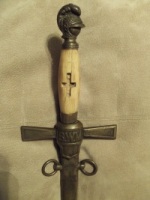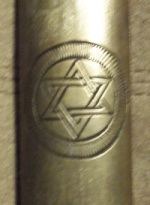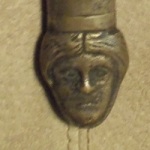Mystery cross
(Puzzle 031)
En garde!

Unfortunately the owner of this sword and its sheath has no information about its age or country of origin, but hopefully there's enough to see from the photos on the right for you to recognise who uses the symbol we've reproduced on the left.
Click on any of the photos to enlarge, and you'll see on the second photo, the pommel at the top of the hilt is shaped as a helmet. Does this give a clue to the sword's origin?
Moving down the hilt, we see on the grip a Voided Cross, where we assume a metal inlay has been removed or dropped out. Alternatively the former owner may have just carved the cross. In either case, it could suggest the owner wanted Christ to guide the hand that held the sword.
The guard consists of a crossbar with the initials "S W M"; which mean what?
An outline of a shield is at the throat of the sheath, beneath which is an engraved crown. If the piece has a military connection, the crown is more like the Swedish coronet than the British arched crown.
Then we come down to the main part of this puzzle; an anchor overlaying a cross, and so far two people have made valuable suggestions:
- A similar symbol has been seen on a Victorian button and may be a rebus for "The Cross is my Anchor".
- Dr Russell Hale, D.Min, LCDR, CHC, USN (Ret) kindly pointed out an almost identical symbol, worn as devices on the lapels and collars of theological students enrolled in the V-12 Chaplain Candidate Program during WWII (1943-1945). (See navybmr.com/study%20material/14282.pdf, page 96.)
One difference between those devices and the symbol on the sword, is that the V-12's anchor shaft is vertical whereas the sword's anchor shaft is slanting ('portate'). Another difference is the sword's cross is behind the anchor, whereas the V-12's cross is in front of the anchor.
On the chaplain insignia of the Royal Navy (UK), Australian Navy, and possibly other former Commonwealth navies, the cross is behind the anchor, like the sword's. But in all those navies, both the cross and anchor shafts are vertical, whereas the sword's cross and anchor shafts are both portate. This doesn't mean, of course, that much older insignia for marine chaplains didn't have a portate arrangement.
At this point we must emphasise that although chaplains (in most western armed forces, at least) have the rank of a military commissioned officer, they are neither commanders not combatants. Consequently they do not bear arms (other than in circumstances requiring small arms for self defence). Dr Hale confirms that a sword, even a ceremonial one such at the one shown on this page, would therefore not belong to a chaplain.
So who did it belong to? A Christian military officer perhaps, and yet we also see the Jewish Star of David. This is encompassed by either a double circle or a ring of Sun Rays, symbolism pointing toward Freemasonry.
The portate angle of the cross is quite a common Freemason symbol, as is the anchor, also the crown mentioned above.
(And although we've discounted the possibility of the sword belonging to a chaplain, we must remember that Christian or Jewish, or indeed any other religion, the chaplain's duties are to all.)
And finally, on the chape (pointed tip of the sheath) is a face.
Is it just our imagination, or is the face mocking us, saying "I know where all the above has come from. Do you?"
If you can identify the sword and/or the symbol, please email us with your thoughts.



